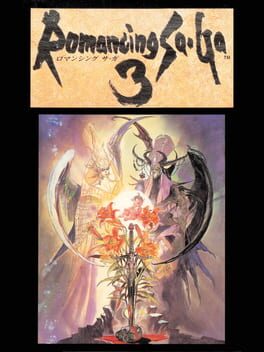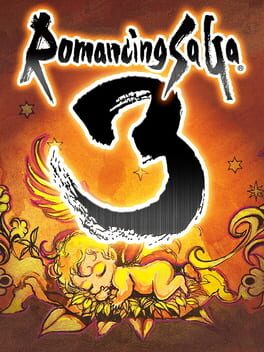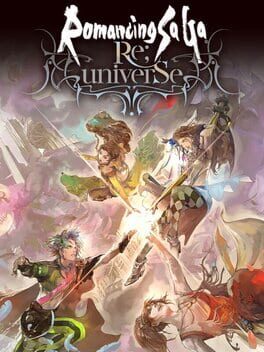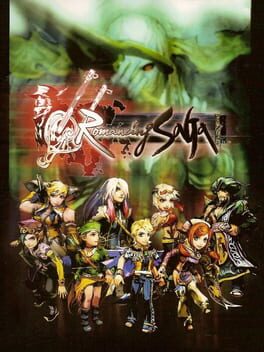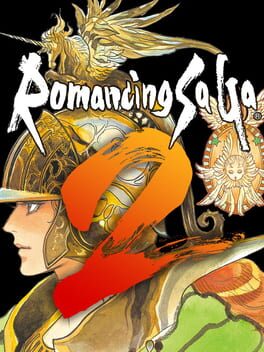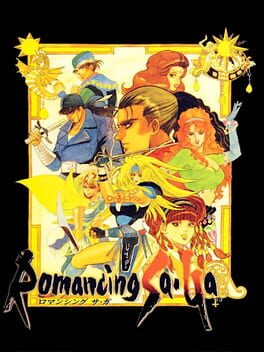

Romancing SaGa is set in the fictional world of Mardias, which was created by the God Marda. Long ago, war raged between three wicked gods, Death, Saruin, and Schirach, and the lord of all gods, Elore. At the end of that long conflict, Death and Schirach were stripped of their powers, and Saruin was imprisoned through the might of the ten Fatestones and the hero Mirsa's ultimate sacrifice. A millennium had passed, and the Fatestones were scattered throughout Mardias. All this time the powers of evil festered, bent on releasing Saruin from his prison.
Also in series
Reviews View More
Romancing SaGa 3 is a favorite among fans of the series, and generally one of the better received titles by non-fans. Naturally, it is my least favorite entry in the series that I've played... so far. I still haven't gotten around to Unlimited SaGa.
On the positive, side, the pixel art is right up there with the the best of the SNES, like FF6 and Chrono Trigger. I'd put the music a step behind those games, but it's still quite good. Character and monster designs are top notch. It really has a strong classic vibe going for it. It's more straightforward mechanically than many of the other SaGa games, as well. It's a pioneer in open world game design, and offered a level of freedom you really wouldn't see elsewhere at the time. RS3 controls far better than RS2, and dodging fights you don't want to take is more enjoyable than frustrating now.
That's mostly where my praise ends, though. If I had to put it succinctly, Romancing SaGa 3 is hollow.
Someone scooped all of the narrative, dialogue, and direction right out of the game. You get a little bit of story at the beginning and a little bit at the end. There's a bad thing that happens every 300 years and chosen ones. You gotta close the abyssal gates to deal with the bad thing and chosen one stuff. That's it. That's basically the whole story. When you get out into the open world, there is essentially no direction and very few bread crumbs for where quests may be hiding. If you don't use a guide, you're liable to spend hours talking to townspeople, hoping that something will happen. Strangely enough, there are pubs with bar keepers you can ask about rumors in most towns, but they only have non-default dialogue for a couple of quests. That would have been a great place for the remaster to add more hints, at the least. Anyway, when you do find a side quest, they feel half baked as well. For example, a village mayor left me for dead when I tried to help him, but when I got out, there was absolutely no reactivity to it. He wasn't sorry or afraid of me, he just went back to his default dialogue. There were a few small scenarios that I enjoyed, though. In particular, one has a masked hero (and a lookalike) protecting townspeople from shady corporate thugs. It was goofy and over the top in a charming way, even if it only lasted a few minutes. There's also a crab man that wants to see the world
The game mechanics feel similarly underdone. There are no species with unique progression systems like the original SaGa trilogy, and no kingdom to manage like Romancing SaGa 2. There is a decent roster of side characters to recruit, but progression is limited to leveling up weapon and magic skills, HP and MP, and sparking techs. Unlike RS2, there are only a few magic spells with utility comparable to just using a weapon tech, buffs wear off fairly quickly, and far more enemies are just outright immune to debuffs. As such, combat largely regressed to the JRPG trope of spamming your most powerful moves and healing as needed.
I say largely, because there was definitely some strategy to be found in choosing the right formation and equipment for a boss encounter. Now, this generally requires you to fight a boss and lose first, rather than be able to dynamically react to the situation, but I do appreciate that I can't just waltz into a boss fight and win every time. That said, bosses have fairly large movesets and seem to pick their attacks at random. They typically have one or two attacks that can really ruin your day via high full party damage or status effects. I think there's literally 3 consumable AoE healing items in the game, but otherwise, all healing and status cure is single target. This means that a bad pattern where the boss spams their dangerous AoEs can just be unwinnable, making victory in a hard fight sometimes feel more like luck than skill or preparation.
Anyway, despite my complaints, I didn't think the game was outright terrible and I did manage to finish it. I can see the sparks of greatness that others love in the game, but they just weren't enough for me. I suppose I can't expect every entry in a long running, highly experimental series to be a hit for me. Oh well, on to the next SaGa!
On the positive, side, the pixel art is right up there with the the best of the SNES, like FF6 and Chrono Trigger. I'd put the music a step behind those games, but it's still quite good. Character and monster designs are top notch. It really has a strong classic vibe going for it. It's more straightforward mechanically than many of the other SaGa games, as well. It's a pioneer in open world game design, and offered a level of freedom you really wouldn't see elsewhere at the time. RS3 controls far better than RS2, and dodging fights you don't want to take is more enjoyable than frustrating now.
That's mostly where my praise ends, though. If I had to put it succinctly, Romancing SaGa 3 is hollow.
Someone scooped all of the narrative, dialogue, and direction right out of the game. You get a little bit of story at the beginning and a little bit at the end. There's a bad thing that happens every 300 years and chosen ones. You gotta close the abyssal gates to deal with the bad thing and chosen one stuff. That's it. That's basically the whole story. When you get out into the open world, there is essentially no direction and very few bread crumbs for where quests may be hiding. If you don't use a guide, you're liable to spend hours talking to townspeople, hoping that something will happen. Strangely enough, there are pubs with bar keepers you can ask about rumors in most towns, but they only have non-default dialogue for a couple of quests. That would have been a great place for the remaster to add more hints, at the least. Anyway, when you do find a side quest, they feel half baked as well. For example, a village mayor left me for dead when I tried to help him, but when I got out, there was absolutely no reactivity to it. He wasn't sorry or afraid of me, he just went back to his default dialogue. There were a few small scenarios that I enjoyed, though. In particular, one has a masked hero (and a lookalike) protecting townspeople from shady corporate thugs. It was goofy and over the top in a charming way, even if it only lasted a few minutes. There's also a crab man that wants to see the world
The game mechanics feel similarly underdone. There are no species with unique progression systems like the original SaGa trilogy, and no kingdom to manage like Romancing SaGa 2. There is a decent roster of side characters to recruit, but progression is limited to leveling up weapon and magic skills, HP and MP, and sparking techs. Unlike RS2, there are only a few magic spells with utility comparable to just using a weapon tech, buffs wear off fairly quickly, and far more enemies are just outright immune to debuffs. As such, combat largely regressed to the JRPG trope of spamming your most powerful moves and healing as needed.
I say largely, because there was definitely some strategy to be found in choosing the right formation and equipment for a boss encounter. Now, this generally requires you to fight a boss and lose first, rather than be able to dynamically react to the situation, but I do appreciate that I can't just waltz into a boss fight and win every time. That said, bosses have fairly large movesets and seem to pick their attacks at random. They typically have one or two attacks that can really ruin your day via high full party damage or status effects. I think there's literally 3 consumable AoE healing items in the game, but otherwise, all healing and status cure is single target. This means that a bad pattern where the boss spams their dangerous AoEs can just be unwinnable, making victory in a hard fight sometimes feel more like luck than skill or preparation.
Anyway, despite my complaints, I didn't think the game was outright terrible and I did manage to finish it. I can see the sparks of greatness that others love in the game, but they just weren't enough for me. I suppose I can't expect every entry in a long running, highly experimental series to be a hit for me. Oh well, on to the next SaGa!
Game Review - originally written by Gideon Zhi (founder of Aeon Genesis Translation Group)
I've always liked the SaGa games, and RS3 is no exception. But by and large they're not for everyone, and RS3 is no exception. Quests not only require effort by the player to complete but also to simply locate, and you are, by and large, dropped into a fairly large world with a general objective (one that differs depending on which character you choose to play as) with little direction on where to go and what to do. It can be quite daunting, but it rewards those who stick with it.
Along the same lines as the nonlinearity of the gameplay is something that scares players substantially less: a nonlinearity, of sorts, of the characters you get. They all start with base statistics and “favored” abilities — Katrina, for example, is particularly skilled with Big Swords — but you can turn just about any character into anything you want them to be, and the “level up” system inherent in SaGa titles since the original on the old greenscreen gameboy has supported this.
Graphically, RS3 is about on par with Final Fantasy 6, but it varies. Some of the areas are absolutely beautiful, but some are fairly bland. It's a bit of a tossup, really. The monsters are exquisitely detailed, however, and some of the effects in battle are a joy to behold.
It should be noted, of course, that SaGa games are known for their difficulty. While the very first was not particularly hard (especially since you could use the Saw on the final boss and kill it in one hit) the second took this reviewer well over a year to beat. While RS3 is not -quite- this tough, I cannot see myself defeating the final boss at any time soon. Even the four major bosses and some of the more “minor” bosses are substantialy harder than you'd normally expect, even with a fair amount of character stat boosting.
RS3 is not for everyone. It can be hard to figure out what to do next, hard to build your characters up, and hard to progress against David-and-Goliath bosses. But if you like hard or open-ended games, give it a spin and you might just be pleasantly surprised.
I've always liked the SaGa games, and RS3 is no exception. But by and large they're not for everyone, and RS3 is no exception. Quests not only require effort by the player to complete but also to simply locate, and you are, by and large, dropped into a fairly large world with a general objective (one that differs depending on which character you choose to play as) with little direction on where to go and what to do. It can be quite daunting, but it rewards those who stick with it.
Along the same lines as the nonlinearity of the gameplay is something that scares players substantially less: a nonlinearity, of sorts, of the characters you get. They all start with base statistics and “favored” abilities — Katrina, for example, is particularly skilled with Big Swords — but you can turn just about any character into anything you want them to be, and the “level up” system inherent in SaGa titles since the original on the old greenscreen gameboy has supported this.
Graphically, RS3 is about on par with Final Fantasy 6, but it varies. Some of the areas are absolutely beautiful, but some are fairly bland. It's a bit of a tossup, really. The monsters are exquisitely detailed, however, and some of the effects in battle are a joy to behold.
It should be noted, of course, that SaGa games are known for their difficulty. While the very first was not particularly hard (especially since you could use the Saw on the final boss and kill it in one hit) the second took this reviewer well over a year to beat. While RS3 is not -quite- this tough, I cannot see myself defeating the final boss at any time soon. Even the four major bosses and some of the more “minor” bosses are substantialy harder than you'd normally expect, even with a fair amount of character stat boosting.
RS3 is not for everyone. It can be hard to figure out what to do next, hard to build your characters up, and hard to progress against David-and-Goliath bosses. But if you like hard or open-ended games, give it a spin and you might just be pleasantly surprised.
